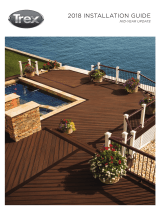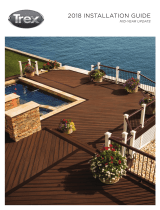Cable
Spacing:
Maximum 3
inches apart.
Intermediate
Posts:
Size all intermediate
posts as required for
cap rail support
strength or for code.
Cap Rail:
Always include a strong, rigid
cap rail that is securely fastened
to all posts. Cap size is based
on load strength needs and
local code requirements.
Set railing height per
local code.
Spacing From Walls:
Set end posts 3 to 4 inches away from the
house/wall face to allow access for attaching
cable end fittings.
End Posts:
Use minimum end post sizes noted above, and
securely bolt or screw to joists or deck surface.
Double Corner Posts:
If possible use double corner posts to allow the cable
to run continuously through the corners without
terminating
(see single corner post option below).
Securely bolt or screw posts to joists or deck surface
and use minimum corner post sizes noted above.
Maximum Post Spacing:
Space all posts and vertical
spacers
(see below)
a maximum
of 3 feet apart to minimize any
deflection that may occur if the
cables are ever forced apart.
Foot Rails (OPTIONAL):
Foot rails should be spaced no
more than 4 inches above the
deck surface, or as required by
local code, and should be sized
as needed for support strength
and design appearance.
Single Corner Post (OPTIONAL):
When terminating on a single corner post, be sure to offset the drill holes at
least 1/2'' to allow internal clearance for the cable fittings. Use minimum end
post sizes noted above and securely bolt or screw to joists or deck surface.
MAX. 3 FEET
MAX. 3 FEET
The Basic Frame Design
And Some Other Options
Cable
Spacing:
Maximum 3
inches apart.
CONSTRUCTION
CHECKLIST
Space cables no more
than 3 inches apart
Space posts/verticals no
more than 3 feet apart
Observe minimum
end/corner post sizes
shown above
Securely fasten all
posts and cap rails
Carefully plan all
termination and
corner posts for proper
clearance, positioning,
and maximum
cable run lengths
Straight runs of cable
(no turns/dips) should
not exceed 70 feet; runs
with corner bends (2
bends at most) should
not exceed 40 feet
Wood Frame Requirements
IMPORTANT NOTE
For railings we recommend
spacing the cables no
more than 3 inches apart
and placing posts or
vertical members no more
than 3 feet apart.
Please note that since
building codes vary by
state, county and city,
our recommendations
may not comply with code
requirements in all areas.
Always consult with your
local building department
before starting your project.
Minimum sizes for all corner and end posts
All other posts should be sized as required for cap rail support strength or for code
4X6 WOOD
3-1/2'' wide, 5-1/2'' thick
Railing frames need to be designed and built strong enough to support the tension of properly installed cables,
which is a load in excess of 300 lbs for each cable. Here are some basic guidelines to help you properly prepare
your railing frames. These guidelines apply whether you are using 1/8'', 3/16'' or 1/4'' cable (1/4'' cable not
recommended for wood frames).
Wood Blocking
(WOOD FRAMES ONLY):
Underneath the cap
rail attach minimum
1”x 4” wood blocking
between posts to pro-
vide additional lateral
reinforcement to the
posts so that they
won’t pull out of
plumb when the
cables are tensioned.
Vertical Spacers (OPTIONAL):
Slender spacers may be used instead of some of the larger intermediate posts to
achieve a more open railing design. These are non-structural members and are
only intended to maintain cable spacing and minimize deflection. Examples are
2” x 2” wood strips, 1” metal tubing or 1/4” flat bar. Attach spacers to the cap
rail and either the foot rail, deck surface or joists.





